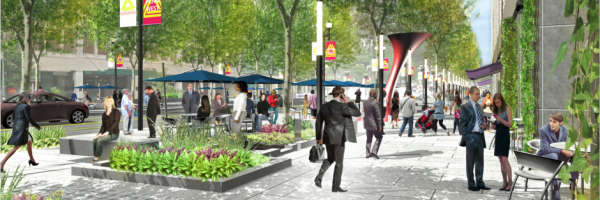PA2040 Public Wi-Fi
Jump to navigation
Jump to search
| PA2040 Public Wi-Fi | |
|---|---|

| |
 PA2040 Project | |
| Team Organizations | Golden Triangle BID PEPCO George Washington University |
| Team Leaders | Anil Sharma |
| Participating Municipalities | Washington DC |
| Status | Implemented |
| Document | None |
Description
Create wireless mesh backhaul infrastructure as part of smart city IoT deployment throughout the 1700 to 1900 blocks of Pennsylvania Avenue, NW, Washington DC to enable public connectivity to services and enhanced connectivity for government operations and public safety. Involves city technology, planning, and transportation agencies, local Business Improvement District (BID), federal District planning agency, and technology solution providers.
Challenges
- Effectively coordinating across city agencies, with federal planning agency, and other stakeholders.
- Ensuring deployment that will be cost effective/within budget, scalable, and replicable to other parts of the city (and potentially other cities).
- Ensuring agreements with utilities for power usage.
- Maintaining adequate resources for sustainable operations– i.e. staffing.
Solutions
TBD
Major Requirements
Public Wi-Fi is a key component of the overall PA2040 project, which is underway. The process followed was:
- Developed and assembled project concept and team in response to presented idea at first Global Cities Team Challenge.
- Defined scope and requirements and project plan.
- Obtained stakeholder buy-in – including MOAs, MOUs, and service contracts.
- Develop system architecture.
- Procured equipment and began process of implementing core infrastructure.
- Conducted proof-of-concept tests
Performance Targets
| Key Performance Indicators (KPIs) | Measurement Methods |
|---|---|
|
KPIs will support goals of the local BID to increase economic activity:
|
|
Standards, Replicability, Scalability, and Sustainability
- Wi-Fi standards used: 802.11AC Hotspot 2.0
- Follows Cisco Unified Wireless Architecture – includes Control and Provisioning of Wireless Access Points (CAPWAP)
- Secure and public and secure SSIDs
- EBGP peering to external networks at 1/10 Gig Ethernet
- Replicability - Standard architecture.
- Scalability - Core supports up to 10,000 APs (current project has only 30 APs) and is considered in other areas in the city and in the region.
- Sustainability – Network is designed to sustain bandwidth use over time with negligent impact.
Cybersecurity and Privacy
TBD
Impacts
- Improved access to mobile services benefiting transportation, amenity wayfinding, and emergency response.
- Enhanced visitor/tourist experience along Pennsylvania Avenue and economic development.
- Improved government operations through better Wi-Fi access to city workers.
- Improved mass transit operations through better Wi-Fi access.
Demonstration/Deployment
- Phase I: Includes full public access to Wi-Fi through deployment of 30 Wi-Fi hotspots in ubiquitous coverage mesh.
- Phase II: Potential integration with applications and sensor devices.